Steven Pressfield's Blog, page 37
January 1, 2020
2 Notes for the New Year
Cartoon by Harry Bliss from the December 30th L.A. Times:
A cat wearing spectacles is sitting at his writing desk scribbling in his journal.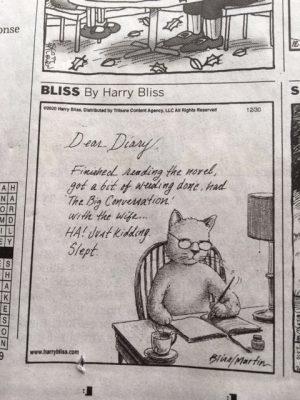
Dear Diary,
Finished writing the novel, got a bit or weeding done, had ‘The Big Conversation’ with the wife …
HA! Just kidding.
Slept.
(The actual cartoon says, “Finished reading the novel.” I tweaked the text for our own special group.)
The second story comes from the ancient world:
The Games sacred to Zeus were held every four years at the city of Olympia in Greece. The stadium is still there. You can walk through the tunnel that the athletes took to enter the arena and even wriggle your toes into the stone grooves that served in ancient times as starting blocks for the races.
In those days, the spectators sat city-by-city. The Athenians took their seats all in one section. Same for the Corinthians, Argives, etc.
The stadium was packed on this particular day, when an elderly gentleman entered seeking a seat.
No one would get up for him.
The old man crossed painfully through the Theban section. Nobody stood. The gentleman next entered the Achaean section; again no person vacated his seat. By now the full stadium had noticed the elderly fellow’s ordeal. They began jeering and mocking him. The man worked his way through the sections of two more cities. Still no one stood. The laughter and derision now dominated the entire field.
The old man next stepped toward the Spartan section. As soon as his foot crossed the margin, every single Spartan stood, offering the gentleman his seat.
At this, the entire stadium burst into applause. The ovation lasted for minutes. When the cheers finally died down, one spectator turned to his neighbor and observed, “See? The Greeks all know what is right. But only the Spartans practice it.”
Happy New Year!
December 25, 2019
Art is Artifice
Art, by definition, is artifice. It’s fake. It’s not “real” in the sense that a sunset is real, or a trout or a pomegranate. Art is a work crafted with calculation, forethought, and skill to create either the simulacrum of something real (a painting of a sunset, say) or to express an insight into, or attempt to bring order out of, nature or the experience of life.
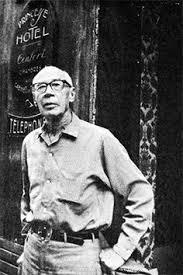
Henry Miller in Paris
Art is made by man, not God. The simple fact that art is made, not discovered or revealed, makes it artifice. But art is also real. The pomegranate in the painting may not be a real pomegranate, but the painting is a real painting. It’s fake life, but it’s real art. Lady Gaga is a fabricated personality, yet who can deny that that personality is real?
In many ways, art is more real than reality. How many of us have wept at simulated grief in a movie, but been unable to cry at the death of a real person in our real life? I’ve watched a million sunsets and many have been spectacular, but I confess that I’ve seen sunsets in movies that looked better than the real thing.
What is Authentic? If an actress delivers an emotion that moves an audience, is her emotion real? Isn’t the actress’ vocation to act–in other words to simulate, to make believe, to pretend? Has she simply created through artifice the likeness of something real but that, itself, is contrived and inauthentic?
We’re speaking, above, of the authenticity of art. But what about the experience of the artist who is trying, herself, to be authentic–to produce something so true to her own self that it resonates with the universal heart of the audience? What is her process? What goes on inside her?
I’ve lived my whole life trying to understand this and to do it. You have as well, I would bet, or you wouldn’t be reading this post. It’s our religion. Here’s how I would sketch its theology:
The belief is that we—each of us as individuals—did not appear in this dimension as tabula rasa, a blank slate. On the contrary, we entered this life already possessing a personality, a daimon, a unique soul, distinct and different from all others’. Even if we are an identical twin, composed of the same DNA as our brother or sister, we are still unique and one of a kind.
Another way to phrase this is that we all have a destiny. Each of us was born for something. Maybe this “something” was shaped by previous lives, or maybe we popped out of the oven fresh and new for the first time. Either way, each of us is as unique as a snowflake or a fingerprint and each of comes with one-of-a-kind gifts.
If this is true (and I believe it is) then our role in life is not to shape ourselves into some ideal that we imagine we ought to be or want to be (which we can’t do anyway), but instead to discover who we already are—and become that.
We are seeking our Authentic Selves. Our quest is to align ourselves with our true nature, our calling, the destiny we were born to fulfill.
The romantic seeks another person—a lover perhaps, or a child, the union with whom will release her from her imprisoning self-preoccupation and “complete” her into her greater and truer self.
The mystic seeks direct experience of the divine. His quest is for his higher nature, to fuse with and become one with the infinite, the transcendent, the Almighty.
The artist—meaning you and I—seeks her life’s work, her calling, the vocation she was put on earth to perform. In finding that calling, she finds herself.
But here’s the weird part: that authentic calling is by definition inauthentic. The calling is to produce art, and art is artifice.
Or is it? No one has ever expressed it better than Henry Miller in Tropic of Capricorn:
I found that what I had desired all my life was not to live—if what others are doing is called living—but to express myself. I realized that I had never had the least interest in living, but only in that which I am doing now, something which is parallel to life, of it at the same time, and beyond it. What is true interests me scarcely at all, nor even what is real; only that interests me which I imagine to be, that which I had stifled every day in order to live.
What have you and I been put on this Earth to do? Is it not the creation of the “inauthentic,” that is the purposefully crafted, in order to deliver to others the gift and simulacrum of authenticity?
That’s why they call it Art, and why, in some crazy way, it’s realer than real and truer than true.
Merry Christmas!
December 18, 2019
Perfectionism = Resistance
Have you ever blown an entire morning noodling with a single paragraph or, worse, a solitary sentence?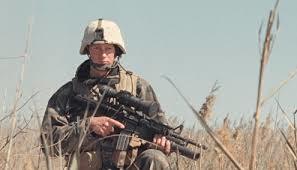
Resistance has outfoxed you.
You have hung up an entire battalion trying to capture an outhouse.
December 11, 2019
Hit the Page Running
My mantra when I finally sit down to work is
Hit the page running.
What I mean by that is to plunge in immediately.
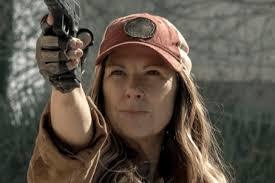
Mo Collins as Sarah Rabinowitz on “Fear the Walking Dead”
First minute.
First second.
First millisecond.
Why do I do this?
Resistance.
I don’t want to give Resistance the slightest opening to worm its way into my brain and start me “thinking.”
No dawdling.
No cogitating.
No mulling over.
Start.
Get to work.
Get into the flow.
If I’m working on Draft #1 of a new project, I will pick up immediately where I left off yesterday. Without “thinking,” I’ll continue telling the story. If I left off yesterday with Uncle Pismo clutching a double-bladed axe in both hands as the leader of the zombies hurtles toward him across the work floor of the abandoned noodle factory, I’m gonna have Pismo sling that weapon first thing.
I wanna get into that fight as fast as I can.
Into the story.
Into the flow.
Remember, our enemy in writing our novel or screenplay is not plot or theme or characters.
Our enemy is Resistance.
If I’m working on Draft #11 of a project, the work is easier. I have pages already. I’ve got the characters, the story, the theme. Momentum is already there on the page.
Still I’ll plunge in, Minute One, without hesitation and without thought.
Pick up where I left off and keep going.
I might go slowly. I might be focusing intently on single words and single beats of punctuation. But I’m relentlessly pushing forward without letting Resistance, in any of its manifold manifestations, weasel its way in.
It goes without saying, I have turned off all external sources of distraction.
No phone.
No e-mail.
No Instagram.
No Facebook.
I am on an ice floe in Antarctica.
I’m circling alone at 70,000 feet.
I’m on the moon.
Barring a zombie apocalypse or a family emergency, I will not turn my attention to anything that’s not happening inside my own demented brain.
December 4, 2019
Ego and Self (and Resistance)
Let’s revisit the quote from Rabbi Mordecai Finley that we cited two weeks ago.
“There is a second self inside you, an inner, shadow Self. This self doesn’t care about you. It doesn’t love you. It has its own agenda, and it will kill you. It will kill you like cancer. It will kill you to achieve its agenda, which is to prevent you from actualizing your Self, from becoming who you really are. This shadow self is called, in the Kabbalistic lexicon, the ‘yetzer hara.’ The yetzer hara, Steve, is what you would call Resistance.”
I believe absolutely that Rabbi Finley’s statement is true.
There is a second self inside us, and it is exactly as Rabbi Finley describes.
But why? Why would such an entity exist? Are you and I half-demonic? Do we have the Alien living inside us?
What would be the purpose—in evolutionary terms, if nothing else—of such a psychic structure?
Seth Godin’s theory is that it’s the “lizard brain,” the amygdala, a holdover from millions of years ago. He may be right.
Here’s what I think:
I think the human being, in her deepest soul-nature, possesses two potential identities.
The ego is one.
The Self, in the Jungian sense, is the other.
I define the ego as the conscious mind, the “I” that applies reason, that sets goals, that helps us navigate the 405 Freeway and the Major Deegan Expressway.
The ego believes certain truths and lives by them. Here are a few.
Death is real. We are all mortal.
Time and space are real.
Each individual human is separate from every other. I can hurt you and it will not impact negatively on me.
The Self, on the other hand, is the deeper “unconscious” mind. It is not rational. It is quantum. It operates beyond the realm of reason and by other, more counterintuitive laws. The Self believes and operates by different truths than the ego.
Death is not real. The soul is immortal.
Time and space are not real. The gods travel “swift as thought.”
Each individual is bound inextricably to every other. If I hurt you, I simultaneously and with equal impact hurt myself.
The primary emotion that the ego lives by is fear.
The primary emotion that the Self lives by is love.
What, then, is Resistance?
Resistance is the weapon the ego uses to prevent the individual from seating her identity in the Self.
November 27, 2019
Resistance Thrives in Darkness
Resistance kicked my butt for almost a decade in my twenties. I’ve written about this in The War of Art. I crossed the country thirteen times in that era, driving my ’65 Chevy van, for no reason whatsoever except that I was running away from myself and my obligation to do my own work and follow my own calling.
But here’s the Big Takeaway:
The reason Resistance won was that I had no idea it existed.
Resistance thrives in darkness.
Resistance loves invisibilty.
Resistance’s most diabolical trick is that it masquerades so convincingly as our own voice.
When you and I hear ourselves thinking,
“You’re a bum, you’re a loser, you’ve got no talent … “
or
“Who do you think you are, dreaming of making a movie, starting a business, writing a book? You? Don’t make me laugh!”
we think that voice is us. We believe that these thoughts are ours, that they are an objective self-assessment offered up by our own rational, reasoning selves.
They’re not.
They’re Resistance.
If you don’t believe me, let me show you the thousands of e-mails and letters I’ve gotten in which totally disparate, unknown-to-one-another individuals report the chatter they hear in their heads.
The voice is identical in every case.
Everyone hears the exact same thing.
The genius of Resistance (and why it’s so powerful) is it convinces each of us that that’s our voice.
If it’s our voice, we’ve gotta believe it, right?
If I could implant one solitary run of thoughts in the brains of everyone on the planet, it would be this:
That negative, self-sabotaging voice you hear in your head is not you.
Those thoughts are not yours.
They are Resistance.
Everyone hears that same voice.
Ignore it.
Resistance thrives in darkness.
Bring Resistance into the light and you defeat it.
November 20, 2019
A Second (Bad) Self
“There is a second self inside you, an inner, shadow Self. This self doesn’t care about you. It doesn’t love you. It has its own agenda, and it will kill you. It will kill you like cancer. It will kill you to achieve its agenda, which is to prevent you from actualizing your Self, from becoming who you really are. This shadow self is called, in the Kabbalistic lexicon, the ‘yetzer hara.’ The yetzer hara, Steve, is what you would call Resistance.”
Rabbi Mordecai Finley, in conversation, July 4, 2010
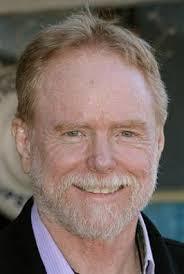
Rabbi Finley
Rabbi Mordecai Finley of Ohr HaTorah congregation in Los Angeles (one of the few rabbis who was a U.S. Marine) is a mentor and friend to me. When I was working on Turning Pro I invited him to breakfast and turned on the tape recorder. The quote above is one of the things that popped out. I came upon it again recently and it struck me with even greater power than it did the first time.
My own conception of Resistance has always been (probably mistakenly) that this force of self-sabotage is “out there” somewhere. I experience it as radiating off the blank page or invading my brain from some other, extra-dimensional location.
Rabbi Finley sees it the other way.
He sees it as a “second self” that lives inside us.
Somehow, to me, that makes it even scarier.
It’s like a sci-fi movie. Like the first Alien.
The first thing I say to myself when I think of Resistance this way (and I do think Rabbi Finley is right) is, Why would our Creator pull such a trick on us?
(Or, if you prefer, Why would Nature/Evolution have evolved us this way?)
Whatever our answer (and I’ve got one for myself), the subjective reality of a “second self” seems undeniable.
This second self seduces us with distractions and excuses. It terrorizes us with visions of our own defeat and humiliation. It whispers to us in the night (and in broad daylight), convincing us that we are without worth, talent, dignity, resolve, courage.
It runs us down.
It sells us short.
It sabotages our best efforts.
It will kill us, as Rabbi Finley says, if we let it.
I declare on the Home Page of this site
Trust me: you will NEVER, NEVER achieve your dreams until you learn to recognize, confront and overcome that voice in your head that is your own Resistance.
The key word here is recognize.
Paradoxically (and aligning perfectly with Rabbi Finley’s statement above) as soon as we recognize this “second self,” fully acknowledge its existence, and grasp the fact that its intentions toward us are diabolically negative, we have found the strategy and the weapon that will help us overcome it.
Awareness first.
Respect for this foe second.
Then: determination and resolution to overcome it.
Our first self is our real self. It is in a battle to the death with our second self.
Which will win?
November 13, 2019
Your Agent Wants a Second Book
As you read this, are you at some point—beginning, middle, or end—in the writing of your first book?
Start thinking about Book #2.
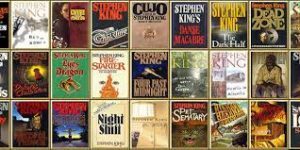
Think of yourself with a shelf like Stephen King’s (partial version here)
I’m serious.
I know when we’re up to our eyeballs in alligators it’s hard to start planning ahead to draining the next swamp.
But athletes think in terms of careers, as do dancers and filmmakers and restaurauteurs and entrepreneurs.
You and I need to too.
Can you picture a shelf of books? Your books.
Ten of ’em.
Fifteen.
Twenty.
Can you imagine not just one title but an actual body of work?
It’s in you.
You can do it.
The Legend of Bagger Vance was my first published novel. I remember my blood running cold as the manuscript was being submitted when my agent, Sterling Lord, called and asked, “What else have you got?”
Of course I had nothing. Not even a glimmer.
“That’s the first thing a publisher will ask me,” Sterling said. “‘What’s his next book?’ I can make a much better deal for Book #1 if I can tell them, ‘Steve’s just finishing the next one and it’s a corker.'”
Beyond such commercial considerations however lies the deeper soul-connection between you and me and our Muse.
The goddess does not like it when we sell ourselves and our gifts short. Can you blame her? She’s the one giving us those gifts.
Thinking beyond Book #1 doesn’t mean we have to sit down and plot out the next seventeen titles. We couldn’t even if we wanted to. The Muse loves to surprise us. She knows what’s coming next and she’ll communicate it to us when she’d good and ready.
But be assured: there is a next one.
And another after that.
Are you forty years old? You’ve got another forty years of writing life, maybe more.
Fifty is nothing for a writer.
Sixty-five is barely a beginning.
An amateur can write one book. You and I must think of ourselves as pros.
A professional thinks in terms of decades.
She thinks in terms of a career.
Start thinking ahead now.
November 6, 2019
Up From the Trenches
About eighteen months ago I wrote a series for this blog titled “Report From the Trenches.” The posts were about a particularly ugly run of months when I was struggling with a book-in-progress that had crashed at the finish line.
The struggle was about starting over.
It was about not caving in to the massive Resistance that arises when you, the writer, have to go back to Square One and rethink everything.
That book was published yesterday.
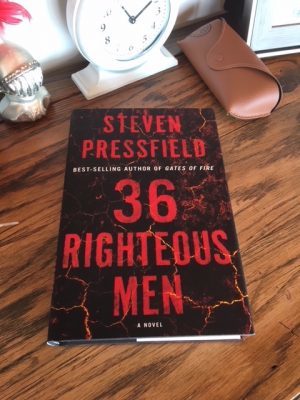
“Too dark, too depressing, too dystopian.”
Like just about everybody who reads this blog, I have a really hard time flogging my own stuff. So all I’ll say is the book is titled “36 Righteous Men,” it’s an apocalyptic thriller that Publishers Weekly called “un-put-downable” and “Pressfield’s most ambitious work to date.”
“36 Righteous Men” is published by W.W. Norton, and it’s on sale everywhere, in bookstores and online.
Oh, one other anecdote:
Even when the rewrite had been completed and the manuscript was what Shawn and I rated a huge success, we still couldn’t find a publisher.
“Too dark,” people said. “Too dystopian.” “Too depressing.”
We tried everywhere.
Nobody wanted it.
We basically gave up.
Three years of backbreaking work down the drain.
Then I had a crazy flash.
My original agent, from Bagger Vance and Gates of Fire days, is Sterling Lord.
Sterling represented Jack Kerouac in 1953. He made the original sale for On the Road.
Sterling is now ninety-eight years old.
I wasn’t sure he was even still speaking to me.
I called him up. “Sterling, I’ve got a new book that nobody wants.”
He said, “Send it over.”
Three weeks later we had a deal.
And not just with any editor but with a legend of the publishing business, Star Lawrence.
In other words, NEVER GIVE UP!
October 30, 2019
Being a Writer is Like Being an Athlete
I’ve never met LeBron James or Tom Brady but I think about them frequently (and other athletes of that same hyper-disciplined mindset) as I go about my day.
They’re human beings, with normal, real-life stuff they have to take care of. But they’re also on a mission. That makes them different from most people … and makes their challenges different too.

Serena Williams gunning for #24
If Serena Williams has a match this afternoon on Centre Court at Wimbledon, she still has to eat breakfast. Pick an outfit. Take care of her hair.
Serena has a baby daughter.
She has a husband.
She has people who need her attention.
Commitments.
Obligations.
Real-world stuff to take care of.
But a part of Serena’s mind is on that match this afternoon.
She has an alarm clock in her head that tells her (or maybe it’s her coach) it’s time to suit up, to stretch, to get warm, to volley a few balls. It’s time to switch mental gears. Time to tune out certain wavelengths and tune in to certain others.
I do that too.
My match is not against a living opponent.
It’s not being televised.
I don’t get a paycheck when it’s over.
But my mindset is the same as Serena’s or Tom Brady’s or Cody Bellinger’s.
When the bell sounds, I have to answer it.



